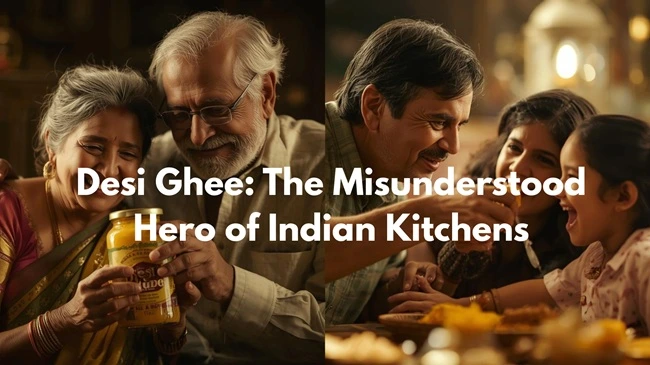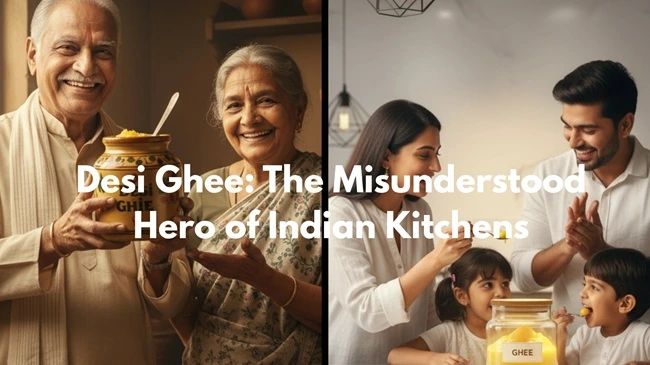The Great Ghee Confusion
Once upon a time, a spoonful of desi ghee in your dal, roti or halwa was a sign of love, care and good health. Our grandmothers swore by it, our festivals celebrated it and every Indian kitchen smelled of its golden aroma.
Then came the modern health wave of low-fat diets, calorie counting and foreign nutrition trends. Suddenly, desi ghee went from being the soul of Indian cooking to the so-called villain for cholesterol.
But here’s the truth no one tells you — desi ghee never changed; our perception did.
So, is ghee really bad for you, or have we just fallen for a global myth that forgot to understand Indian roots? Let’s break it down, layer by layer — just like the ghee in your paratha.

What Exactly Is Desi Ghee?
Desi ghee isn’t just another fat. It’s clarified butter made from cow’s or buffalo’s milk, slowly simmered to remove milk solids and water. What remains is pure, aromatic fat rich in nutrients, used in Indian kitchens for thousands of years — not just for cooking but also in Ayurvedic medicine and rituals.
Unlike refined oils or margarine, ghee contains short-chain fatty acids, antioxidants and fat-soluble vitamins (A, D, E, K), all essential for overall health and hormonal balance.
Why Indian Generations Thrived on Ghee
Before modern oils took over, ghee was the heart of every Indian meal. From dal tadkas in Punjab to Kerala’s ghee roast, it wasn’t just about taste — it was fuel for the body.
Our ancestors worked long hours, often outdoors and needed energy that lasted — ghee provided that slow, steady burn without spiking blood sugar levels.
Ayurveda calls ghee a “sattvic” food — meaning pure, balanced and nourishing for both the mind and body. It’s believed to enhance digestion, improve memory and promote longevity.
No wonder it was often called “liquid gold.”
The Myth: Ghee Is Bad for the Heart
Let’s address the elephant in the room.
When global studies in the 80s linked saturated fats to heart disease, ghee got dragged into the controversy. Western diets, heavy on red meat and processed fats, were compared to Indian diets — a completely unfair comparison.
Modern research now shows that not all saturated fats are equal.
Ghee, unlike trans fats found in processed oils, contains butyric acid, known to improve gut health and reduce inflammation. Even the American Journal of Clinical Nutrition found that moderate consumption of ghee didn’t increase heart disease risk in traditional Indian populations.
The problem isn’t ghee — it’s how much we eat and what we eat it with. Overusing it on junk foods isn’t tradition, it’s misuse.
Desi Ghee vs. Refined Oils: The Real Health Debate
| Feature | Desi Ghee | Refined Oil |
|---|---|---|
| Source | Natural (cow/buffalo milk) | Chemically processed seeds |
| Nutrients | Vitamins A, D, E, K + CLA + Butyric acid | Stripped during refining |
| Smoke Point | High – perfect for Indian cooking | Lower – breaks down into toxins |
| Shelf Life | Long and stable | Often contains preservatives |
| Taste | Rich and aromatic | Neutral, lacks flavor |
It’s time we stop fearing traditional fats and start questioning what’s really refined — our oils or our ideas.
Ayurvedic Wisdom: Ghee for Body and Mind
Ayurveda regards ghee as a “Rasayana” — a rejuvenating food.
It’s believed to:
- Nourish body tissues and improve skin glow
- Support joint flexibility and brain function
- Balance digestive fire (Agni)
- Aid nutrient absorption
No surprise, ghee is used in Ayurvedic medicines, detox therapies and even religious rituals. It’s more than food – it’s culture, medicine and tradition wrapped into one spoonful.
Why Modern Parents Are Reintroducing Ghee to Family Meals
After years of fear-driven diets, Indian parents are realizing that cutting ghee doesn’t equal health.
Doctors and nutritionists are recommending moderate use — especially for growing kids. Ghee helps absorb fat-soluble vitamins, improves immunity and provides healthy calories that developing bodies need.
A simple drizzle over chapati or khichdi does more good than any “imported superfood.”
How Much Ghee Is Too Much?
Balance is the key.
Most experts recommend 1–2 teaspoons per meal, depending on your activity level and overall diet.
If you’re eating home-cooked meals, using ghee in moderation is perfectly healthy. It’s only when paired with processed, fried or sugar-heavy foods that it becomes a problem.
Signs You’re Using Good Quality Desi Ghee
- It solidifies at room temperature and melts easily when warmed.
- Smells slightly nutty or caramel-like.
- Made from A2 cow milk or cultured butter, not vegetable fats.
- No artificial coloring or strong synthetic aroma.
Always check the label — or better yet, get it locally from a trusted source or make it at home.
The Emotional Connection: Ghee Is More Than Just Food
In Indian homes, ghee isn’t just an ingredient — it’s a symbol of care.
A mother serving warm ghee-soaked rotis isn’t adding calories, she’s adding love. It’s a ritual, a memory and a comfort that connects generations.
And in an age of health obsessions and imported diets, maybe it’s time we trust the wisdom that kept our ancestors strong, agile and happy.
Final Thoughts: The Real Hero of Indian Health
Desi ghee isn’t the villain it’s made out to be. It’s the unsung hero that got buried under modern misconceptions.
When consumed mindfully, it supports immunity, digestion, skin health and emotional well-being.
So the next time someone tells you ghee is unhealthy, just smile — and pass them a hot paratha with a generous dab of desi ghee.
Because sometimes, our grandmothers knew more than any nutrition label ever will.
For more Health and Lifestyle Updates, Follow Popnewsblend.com

Hi, I’m Prashant Jain — a curious soul, storyteller, and content creator at heart.I’ve always been drawn to the world of entertainment, travel, sports, health & lifestyle — not just as a writer, but as someone who genuinely lives these experiences. Whether I’m binge-watching the latest OTT series, exploring offbeat spiritual destinations in India, or diving deep into wellness routines and cricket match insights, I love sharing what I discover with like-minded readers.
PopNewsBlend is my way of blending personal journeys with meaningful stories — ones that inform, inspire, and keep you ahead of the curve. Everything I write comes from real observations, hands-on experiences, and a deep passion for understanding the world around us.
Discover more from Popnewsblend
Subscribe to get the latest posts sent to your email.








Pingback: Post-Diwali Detox: How to Get Back to a Healthy Routine After Sweets & Feasting